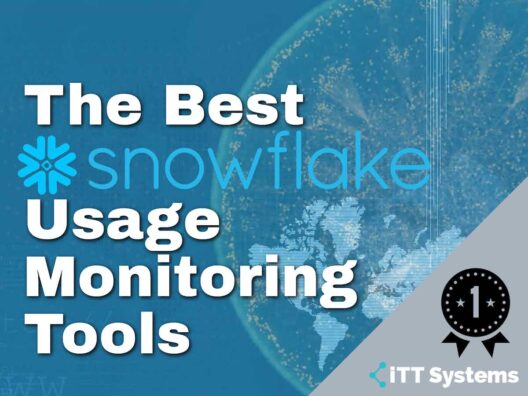Data analytics is an essential and the most significant part of every business as it helps to optimize performance, try new avenues, improve efficiency, reduce costs, and more. In addition, the insights gleaned from data analytics will reflect across all areas of the organization and translate into better decision making, finding lucrative marketing opportunities, improving customer support, etc.
Now comes the big question. How do you gather data and perform detailed analytics on it to get the insights you want? Thankfully, it's easier than you think, thanks to the availability of advanced business intelligence tools like Snowflake.
Here is our list of the best tools for Snowflake usage monitoring:
- Datadog This comprehensive tool provides complete visibility into Snowflake’s architecture and helps optimize its usage.
- NewRelic NewRelic has integration for Snowflake to monitor its usage, performance, security, and availability.
- Microsoft PowerBI This tool natively integrates with Snowflake to gather and analyze data for rich insights.
- Tableau This interactive data visualization tool helps you to view data and understand its underlying patterns.
- Talend This platform integrates with Snowflake to ensure the integrity of its data warehouse during every stage of its life cycle.
- Sigma Computing This tool allows you to query and export data directly from Snowflake, thereby helping you make the most of it.
- Qlik This is a data analytics solution that helps organizations use data to make sound decisions and solve their most complex problems.
What is Snowflake?
Snowflake is a Business Intelligence tool that combines cloud-based data storage and analytics to enable users to store and analyze their data on the cloud. It runs on Amazon AWS, Microsoft Azure, and the Google Cloud Platform.
This tool offers what's called cloud data warehouse-as-a-service, which means users can access the tool at any time, scale it up or down depending on their requirements, and make the most of its services for a monthly fee. But, of course, the most significant advantage is companies don't have to invest in costly hardware or software to store their data and analyze it.
This ease of use has made Snowflake a critical tool in any company's BI arsenal.
However, like any tool, Snowflake can also end up having glitches and problems. But then, these glitches can cost millions of dollars for you. To avoid these costly issues, you must invest in reliable monitoring tools that will identify problems in Snowflake proactively, so you can fix the same before it impacts your applications or end-users.
Further, your monitoring tool should also track your Snowflake usage since you will be charged based on your usage levels.
Keeping these considerations in mind, let's now jump into the detailed specifications of each of these tools, so you can choose the one that best meets your business requirements.
The Best Tools for Snowflake Usage Monitoring
Our methodology for selecting Snowflake monitoring tools and software
We reviewed various Snowflake monitoring tools and analyzed the options based on the following criteria:
- Support for various installations and versions of Snowflake
- Ability to integrate into other popular monitoring platforms
- Ability to monitor other applications alongside Snowflake
- A facility to analyze network performance over time
- Graphical interpretation of data, such as charts and graphs
- A free trial period, a demo, or a money-back guarantee for no-risk assessment
- A good price that reflects value for money when compared to the functions offered
1. Datadog
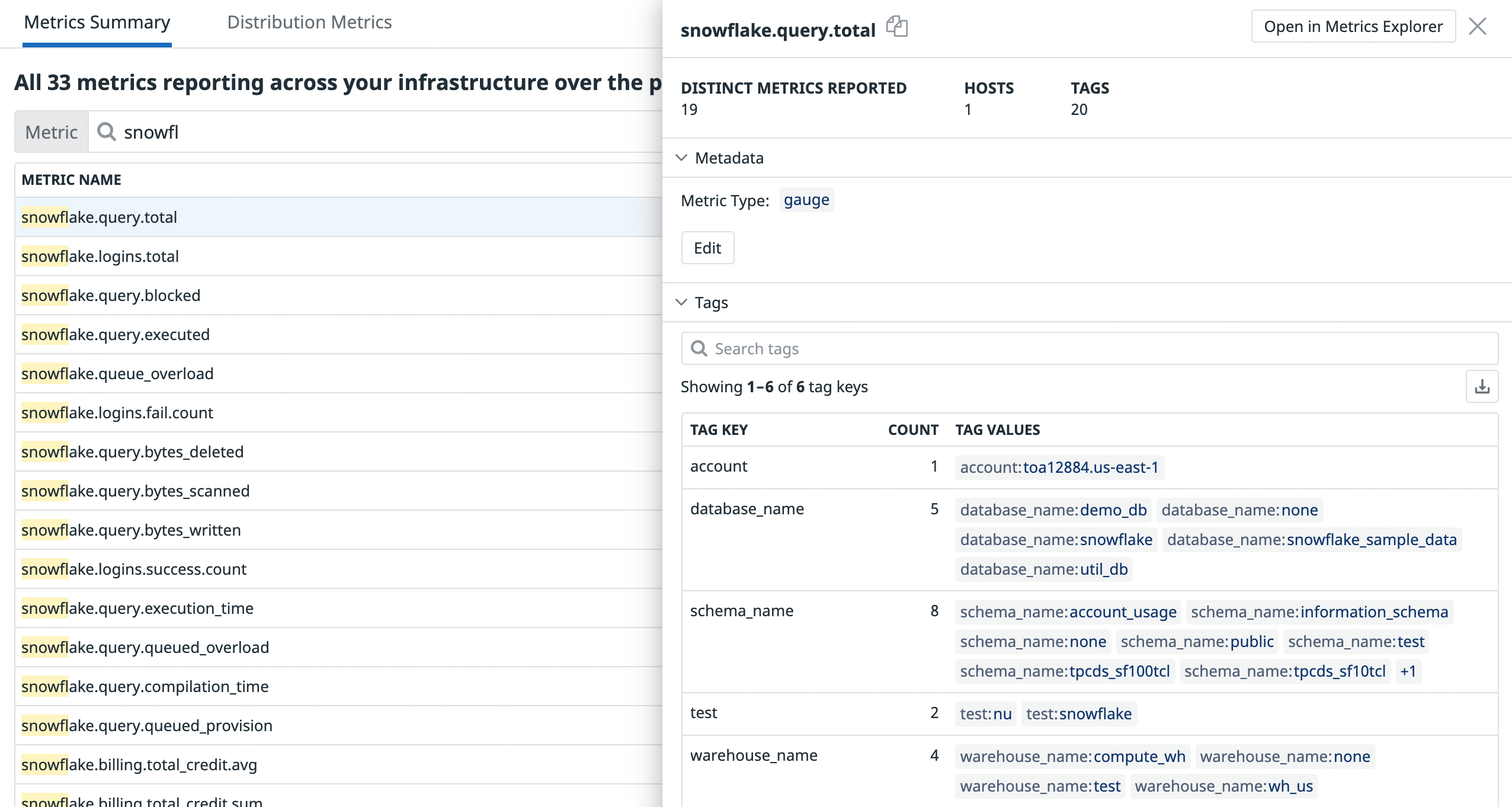
Datadog is a comprehensive Snowflake monitoring tool that provides end-to-end visibility into the architecture and working of Snowflake and enables you to get the most out of it.
Key Features:
- Detects deviations in usage by comparing current use with historical patterns.
- Monitors fluctuations in storage usage.
- Identifies abnormal spikes so that you can address them at the earliest.
- Ensures that temporary and transient tables don't take up more than a day's worth of storage space.
- Enables you to configure a forecast monitor for queries to prevent any overload and, through it, performance degradation.
- It makes intelligent predictions about upgrades, and accordingly, you can resize the Snowflake warehouse or add more clusters to accommodate the current workload.
- Ingests metrics about local and remote data spilling to identify spikes or performance issues before impacting the end-user.
- Monitors the credits used, based on which you can adjust the auto-suspend value of Snowflake.
- Provides deep insights into how Snowflake computes credits.
- Generates a report of Snowflake usage by teams and team members for greater accountability.
- Spots misconfigurations, especially in the cloud services layer, so you can make the required changes for greater efficiency.
- Stays on top of login details, focusing on failed logins, as this can indicate a brute force attack.
- Provides crucial insights into every layer of SNowflake to enhance its optimization and usage.
- Integrates with 600+ tools to give you a unified picture of Snowflake's impact on the overall infrastructure.
Why do we recommend Datadog for Snowflake Monitoring?
Datadog provides an in-depth and comprehensive monitoring solution for Snowflake, with capabilities to detect usage deviations, monitor storage fluctuations, and identify performance issues. Its predictive analytics for warehouse resizing and integration with a wide range of tools make it a versatile choice for ensuring optimal Snowflake performance.
Who is it recommended for?
Datadog is ideal for businesses that require a holistic view of their Snowflake environment as part of their broader IT infrastructure. Its ability to provide detailed insights into usage and performance makes it suitable for organizations of all sizes looking to optimize their Snowflake operations.
Pros:
- Offers numerous real user monitors via templates and widgets
- Can monitor both internally and externally giving network admins a holistic view of network performance and accessibility
- Changes made to the network are reflected in near real-time
- Allows businesses to scale their monitoring efforts reliably through flexible pricing options
Cons:
- Would like to see a longer trial period for testing
EDITOR'S CHOICE
Datadog stands out as the top choice for Snowflake monitoring due to its comprehensive end-to-end visibility into Snowflake's architecture and operations. It excels in detecting deviations in usage, monitoring storage fluctuations, and identifying abnormal spikes, which are crucial for maintaining optimal performance.
The tool's capability to predict upgrades and make intelligent resizing decisions for Snowflake warehouses enhances its utility. Additionally, Datadog's integration with over 600 tools offers a unified view of Snowflake's impact on overall infrastructure, making it an indispensable tool for businesses looking to maximize the efficiency and performance of their Snowflake environment.
Download: Download a 14-day free trial
Pricing: Datadog offers a ton of plans to suit your business needs. Visit the pricing page or contact the customer team to get a quote based on your requirements.
Download: Click here for a 14-day free trial.
2. NewRelic
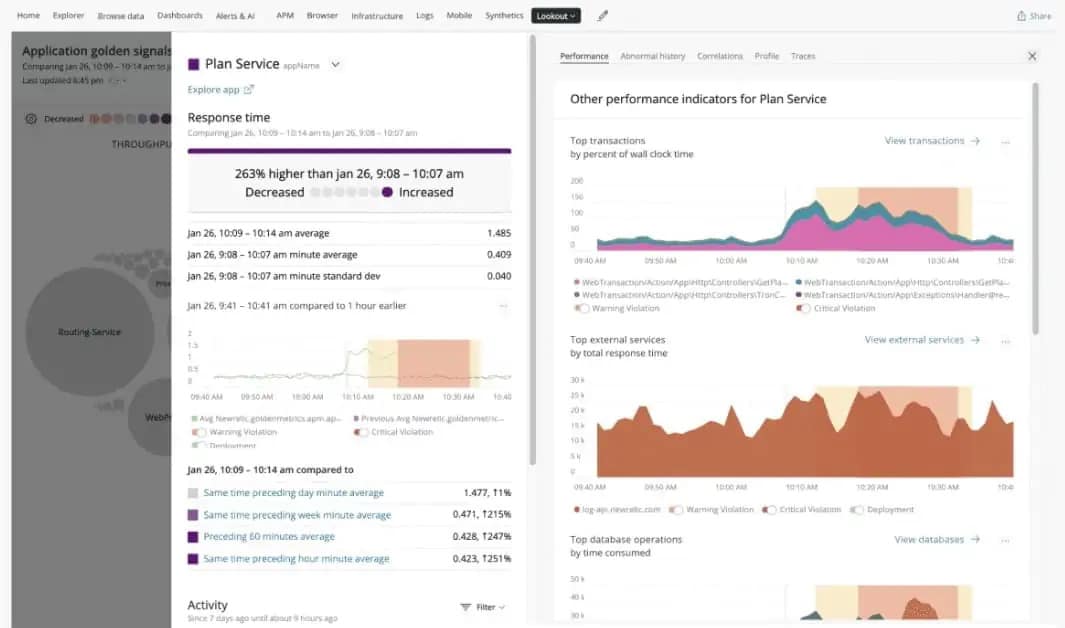
NewRelic monitors Snowflake across many areas, such as cost, performance, security, and availability, to give you complete visibility into the impact of Snowflake on your business operations.
Key Features
Here's what NewRelic's Snowflake monitoring can do for you:
- Identifies poor query performance and helps with the root-cause analysis as well.
- Sends alerts when query performance falls below threshold limits, especially when disk spillage and the queries being queued are high.
- Makes it easy to resize the warehouse or enable more clusters.
- Points out inefficient and poorly written queries.
- Tracks the number of logins, especially the failed ones, to reduce the chances of unauthorized access.
- Collects a wide range of performance-related data to get complete visibility.
- Enables you to ingest any data stored in Snowflake.
- Allows you to stay on top of orders and revenue in real-time.
- Makes it easy to export custom data from Snowflake.
Why do we recommend NewRelic for Snowflake Monitoring?
NewRelic offers extensive monitoring of Snowflake, covering aspects like cost, performance, security, and availability. It excels in identifying poor query performance and inefficient queries, along with tracking login activities for security purposes. Its alert system and performance data collection provide a complete overview of Snowflake's impact on business operations.
Who is it recommended for?
NewRelic is particularly suited for businesses looking for a detailed analysis of Snowflake's performance and its cost implications. Its features are beneficial for organizations that need to manage and optimize their Snowflake environment effectively.
Pros:
- Certified for Microsoft Azure monitoring
- Uses anomaly detection to highlight abnormal behavior in your Azure environment
- Uses simple but intuitive admin dashboards
Cons:
- Better suited for small to medium-sized Azure networks
Pricing:
There are four pricing plans to choose from, and they are:
- Free
- Standard
- Pro
- Enterprise
Contact the sales team for a custom quote on the above plans.
Download: Click here to sign up for a new account and get started.
3. Microsoft Power BI
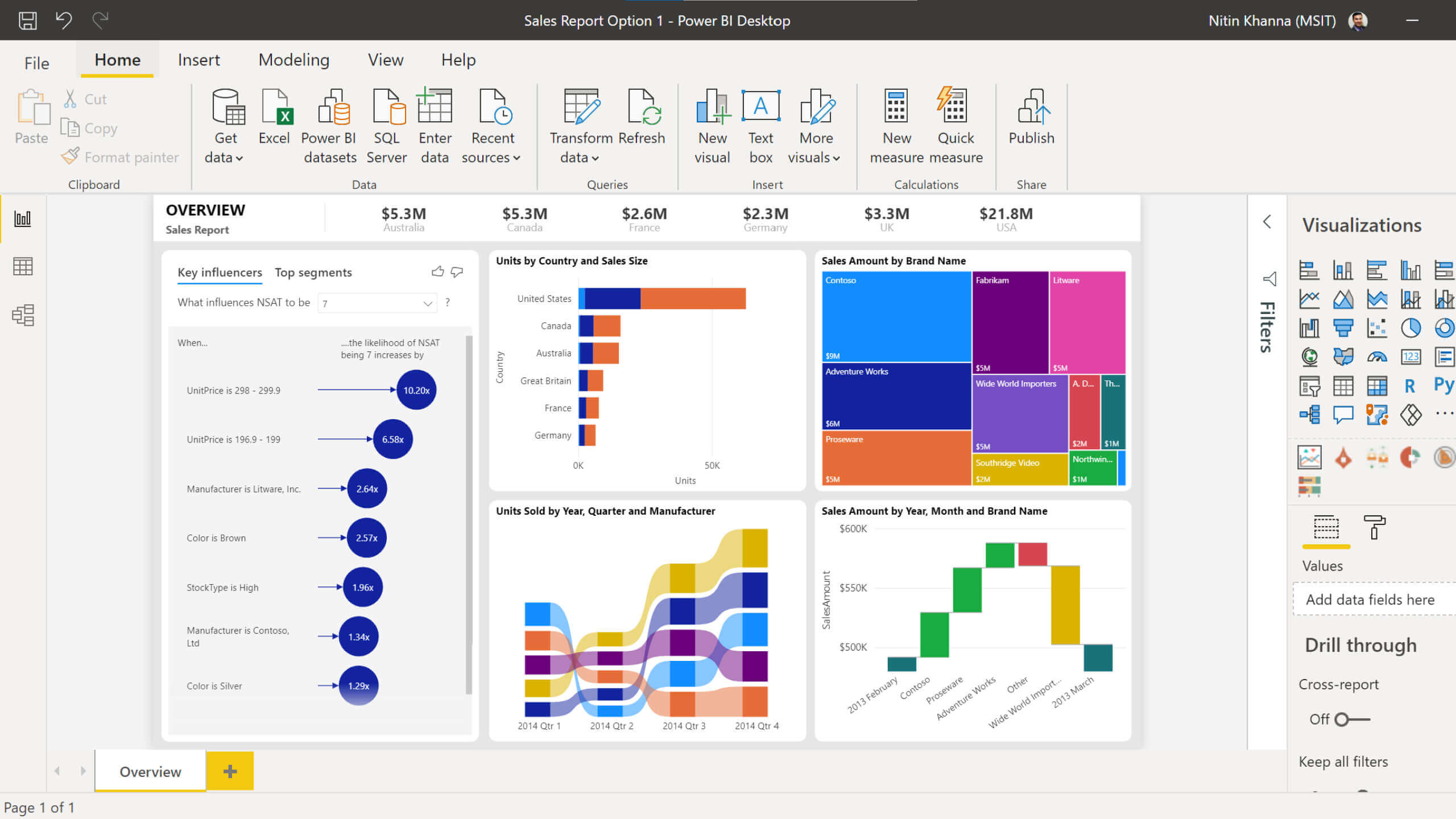
Microsoft Power BI is a data analytics tool that integrates natively with Snowflake so that you can use the Snowflake data just like any other data source on the Power BI desktop. The biggest advantage is you get a complete understanding of the performance and operations on Snowflake separately and also in conjunction with the rest of your infrastructure.
Key Features
The features of Microsoft Power BI concerning Snowflake usage monitoring are:
- Offers the choice to import data directly from your Snowflake computing warehouse.
- This Snowflake connector comes as a part of the Power BI Service and Power BI Desktop, so no separate installation is required.
- Provides support for Azure Active Directory (AAD) authentication and single sign-on.
- Generates paginated reports that give insights into the working and usage of Snowflake.
- Has mobile apps for instant connectivity.
- Supports bookmarks to find what you want quickly.
- Enhances collaboration by allowing teams to discuss the data and their analysis.
- Provides comprehensive insights into Snowflake's usage and performance, so you can take necessary action when required.
Why do we recommend Microsoft Power BI for Snowflake Monitoring?
Microsoft Power BI integrates seamlessly with Snowflake, providing robust data analytics and visualization capabilities. It offers direct import options from Snowflake, supports Azure Active Directory authentication, and generates insightful reports, making it a valuable tool for understanding Snowflake's performance within the broader data landscape.
Who is it recommended for?
Microsoft Power BI is ideal for businesses already utilizing Microsoft products and looking for a native analytics solution for Snowflake. Its ease of use and comprehensive insights make it suitable for teams seeking to enhance collaboration and data-driven decision-making.
Pros:
- Features hundreds of pre-made templates
- Integrates directly with Snowflake
- Works well across Microsoft products
- Supports complex flows for advanced automation
Cons:
- Best suited for small to medium-sized businesses
Pricing:
There are two editions, namely,
- Power BI Pro – $9.99 per user per month.
- Power BI Premium – $20 per user per month or $4,995 per capacity per month.
Download: Click here to try Microsoft Power BI for free.
4. Tableau
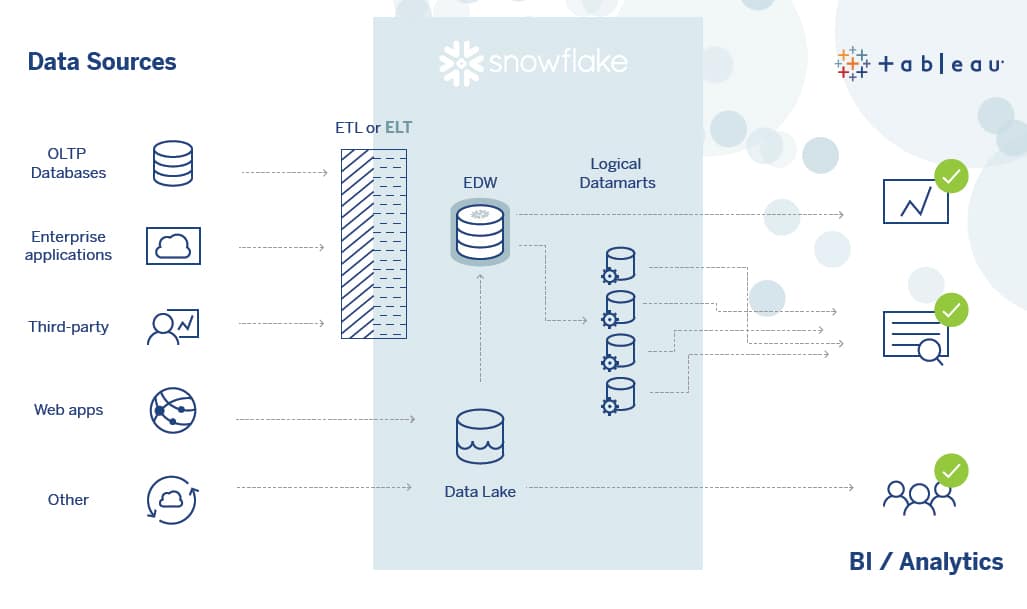
Tableau is a data visualization software that connects to Snowflake to create visualizations of the underlying data for efficient decisions.
Key Features
The features of Tableau are:
- Creates a data culture where teams leverage data patterns to make decisions.
- Provides a snapshot of the performance and cost-value of Snowflake at any time.
- Offers insights into user adoption rate and the number of available users per database so that you can budget and compute the costs accordingly.
- Comes with stunning dashboards that provide all the information you need in one place.
- Provides a “Quick Start” feature to connect to Snowflake automatically.
- Makes it easy to scale virtual warehouses to reduce costs and improve efficiency.
- Enables transparency across your Snowflake usage.
- Supports OAuth for authentication.
- Creates robust and optimized connectivity with Snowflake.
- Strives to provide outcome-based analytics.
- Helps you make the most of your data.
Why do we recommend Tableau for Snowflake Monitoring?
Tableau is recommended for its effective data visualization capabilities when connected to Snowflake. It offers insights into user adoption rates, database utilization, and cost-value performance. Tableau's easy integration and intuitive dashboards make it an excellent tool for transforming Snowflake data into actionable insights.
Who is it recommended for?
Tableau is best suited for organizations seeking a user-friendly platform to create visualizations and analyze data from Snowflake. Its features cater to businesses that require a quick and easy understanding of their data for efficient decision-making.
Pros:
- Offers a fast and easy integration into your Snowflake environment
- Provides cost and usage monitoring features out of the box
- Features a simple interface
Cons:
- Would like to see a longer trial period for testing
Pricing:
Tableau offers three pricing options, and they are:
- Tableau Creator – $70 per user per month. Supports end-to-end analytics workflow.
- Tableau Explorer – $35 per user per month. Provides full self-service analytics.
- Tableau Viewer – $12 per user per month. Views and interacts with dashboards and other visualizations.
Download: Click here for a free trial.
5. Talend
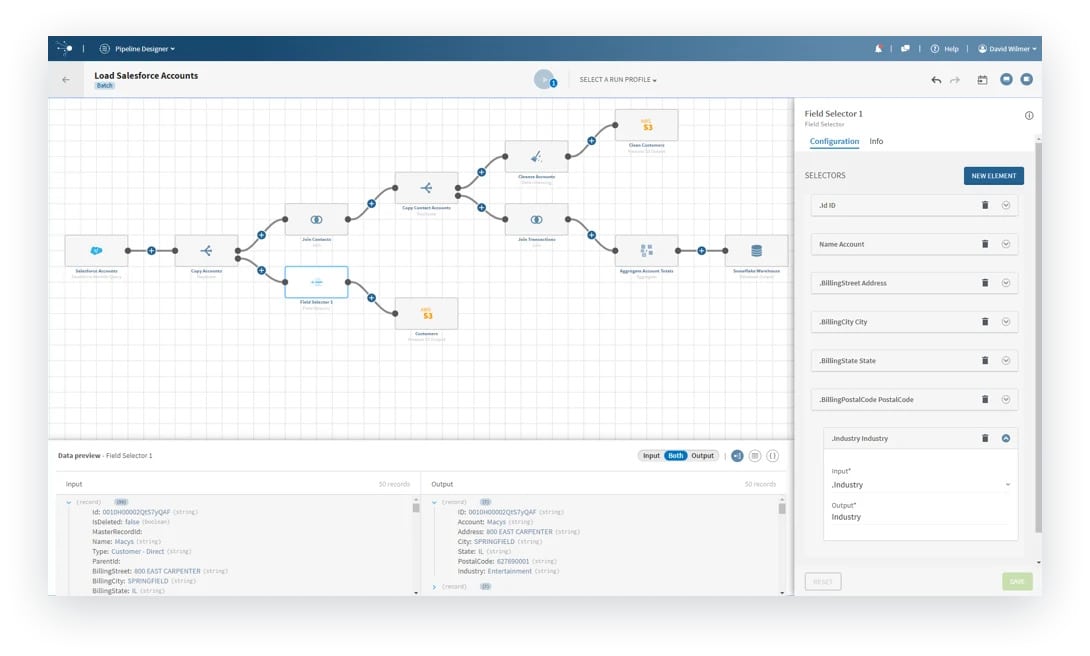
Talend integrates with Snowflake to enable in-depth data analysis across multiple cloud environments and, in the process, improves data accuracy and increases the speed of access.
Key Features
The features of Talend are:
- Makes it easy for enterprise users to verify their data.
- Maintains compliance.
- Automates the process of data migration.
- Provides insights into the security, availability, and reliability of your data.
- Helps to mitigate risks.
- Combines data integration and governance.
- Automatically cleans and profiles data in real-time.
- Checks the reliability of any data set with its trust score.
- Improves your operational efficiency by giving quick insights about the usage of Snowflake.
- Simplifies your data landscape.
Why do we recommend Talend for Snowflake Monitoring?
Talend integrates with Snowflake to provide in-depth data analysis across multiple cloud environments. It automates data migration processes, maintains compliance, and improves operational efficiency with real-time data cleaning and profiling. Talend's trust score feature and comprehensive data analysis tools make it a robust solution for improving data accuracy and access speed.
Who is it recommended for?
Talend is suitable for larger enterprises that require extensive data integration and governance capabilities. Its features are beneficial for organizations looking to ensure data accuracy and compliance in their Snowflake environment.
Pros:
- Offers Snowflake monitoring as well as other data analysis tools
- Provides Snowflake tailored monitors and dashboards
- Is highly intuitive and easy to use
- Has use well beyond Snowflake monitoring
Cons:
- Better suited for larger deployments and enterprises
Pricing:
Talend offers four different plans and they are:
- Stitch – Provides data replication for your data and business analysts.
- Data Management Platform – Ideal for data professionals and teams.
- Big Data Platform – Provides advanced analytics for cross-team initiatives.
- Finally, data, Fabric – Offers complete data integration and sharing solutions across the entire enterprise.
Download: Click here for a free trial.
6. Sigma Consulting
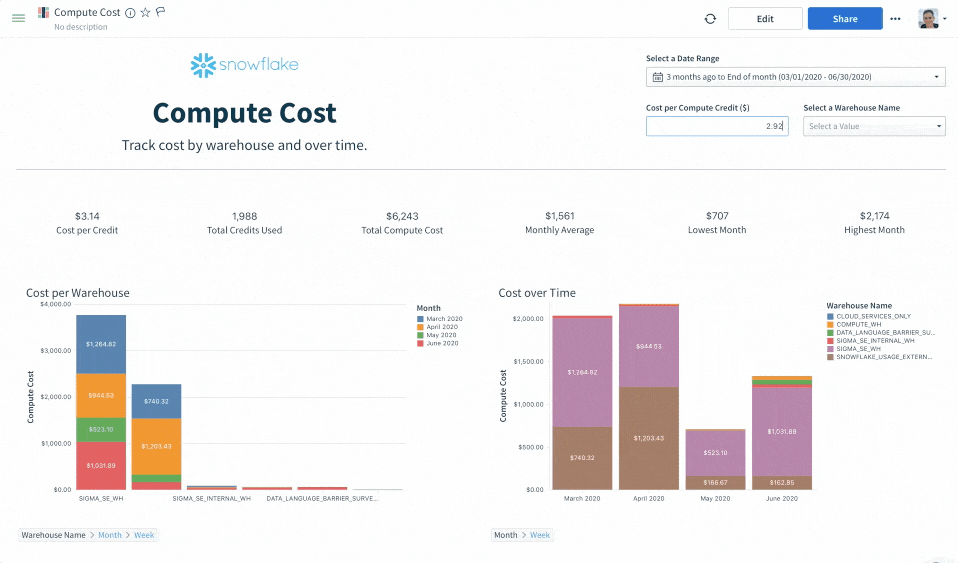
Sigma Consulting has partnered with Snowflake to amplify the impact of cloud-based business intelligence for your organization.
Key Features
The features of Sigma Consulting are:
- Offers cloud-native analytics that can get critical insights into Snowflake's performance.
- Allows you to sort, filter, calculate, join, and do more with the data collected from Snowflake.
- No SQL or manual coding is required for data handling.
- Collects data within minutes from Snowflake and requires no complex configuration or setup.
- Makes it easy to pull and merge data from Snowflake with the data from the rest of the organization to gain critical business insights.
- Extracts value from the JSON files stored in Snowflake.
- Protects your data with streamlined access.
- Enables secure collaboration among teams.
- Helps to query and reuse data easily.
- Generates powerful visualizations across the entire cloud ecosystem.
- Provides contextually-relevant analytics for apps.
- Its out-of-the-box usage dashboards provide a snapshot of usage and costs.
- The entire setup process is easy and takes less than five minutes.
Why do we recommend Sigma Consulting for Snowflake Monitoring?
Sigma Consulting offers cloud-native analytics with an emphasis on ease of use, requiring no SQL or manual coding for data handling. Its quick data collection from Snowflake and integration with organizational data provide critical business insights. Sigma's no-code approach and easy setup make it a practical choice for organizations looking for straightforward yet powerful Snowflake analytics.
Who is it recommended for?
Sigma Consulting is ideal for businesses looking for a simple, yet informative reporting tool for Snowflake monitoring. Its no-code solution is particularly beneficial for teams requiring quick setup and minimal configuration.
Pros:
- Simple yet information reporting – great use of color to highlight metrics
- Great no-code option for monitoring
- Collects data right away – can be used with little configuration
Cons:
- Must contact sales for pricing
Pricing: Contact the sales team for a custom quote.
Download: Click here to try Sigma's Snowflake integration for free.
7. Qlik
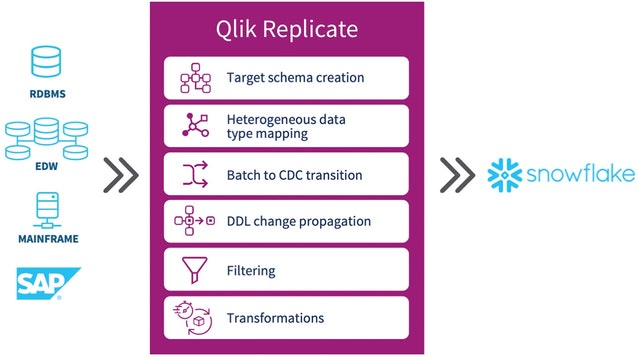
Qlik is a business analytics and data visualization platform that gathers data. It presents it in such a way to ease your decisions and, through it, find solutions to your challenging problems.
Key Features
The features of Qlik are:
- Empowers all employees to make data-driven decisions.
- Provides the context for data and deep insights into the inter-connectivity, all of which help make sense of the data.
- Comes with interactive dashboards that give the insights you need.
- Supports search and conversational modes.
- Sends alerts and takes proactive actions when the values go beyond existing thresholds.
- Comes with machine learning and predictive analysis for a better understanding of the data.
- Combines real-time data pipeline with action-oriented capabilities.
- Enables collaboration among teams.
- Automatically triggers actions when required or based on pre-existing configurations.
Why do we recommend Qlik for Snowflake Monitoring?
Qlik is recommended for its comprehensive business analytics and data visualization capabilities. It empowers employees with data-driven decision-making tools, offers interactive dashboards, and supports advanced features like machine learning and predictive analysis. Qlik's ability to combine real-time data with action-oriented capabilities makes it a robust platform for Snowflake monitoring.
Who is it recommended for?
Qlik is best suited for large enterprises looking for a sophisticated data management and visualization platform. Its extensive features and enterprise-focused design make it ideal for organizations requiring detailed analytics and decision support systems.
Pros:
- Highly customizable admin dashboard – great for NOCs
- Designed with enterprise data management in mind
- Offers widget for cost estimates and Snowflake usage
- Feature robust reporting and auditing templates
Cons:
- Not ideal for smaller networks
Pricing:
Qlik offers two pricing plans.
- Qlik Sense Business – $30 per user per month. Ideal for small groups and teams.
- Qlik Sense Enterprise SaaS – Ideal for large departments and organizations. Contact the sales team for a custom quote.
Download: Click here for a free trial.
Thus, these are some of the best tools that you can use for monitoring Snowflake's usage and performance.
Final Thoughts
To wrap up, Snowflake is a popular cloud-based data storage that supports analytics to give you the intelligent insights required for making suitable business decisions. Since this is an integral part of your infrastructure, it requires regular monitoring, especially availability and reliability.
Further, Snowflake is based on a pay-as-you-use model, which means the costs can quickly add up. So, you'd want a tool that would monitor its usage as well.
The tools mentioned above come with advanced features for monitoring Snowflake, and a lot of them also natively integrate with it to give a seamless experience. We hope this post helps you to make a decision that would augur well for your business.
Snowflake Usage Monitoring Tools FAQs
What types of information can be collected by a Snowflake usage monitoring tool?
A Snowflake usage monitoring tool can collect information about query performance, usage patterns, user activity, data usage, and other metrics related to Snowflake usage.
What are some common Snowflake usage monitoring tools?
Common Snowflake usage monitoring tools include Snowflake's built-in monitoring capabilities, as well as third-party tools such as Datadog, New Relic, and CloudWatch.
How can a Snowflake usage monitoring tool help me optimize query performance?
A Snowflake usage monitoring tool can help you optimize query performance by identifying slow or resource-intensive queries and providing insights into query patterns and usage.
How can a Snowflake usage monitoring tool help me ensure compliance with data privacy and security regulations?
A Snowflake usage monitoring tool can help you ensure compliance with data privacy and security regulations by providing insights into data usage and access patterns, monitoring for unauthorized access, and tracking compliance with data retention policies.

